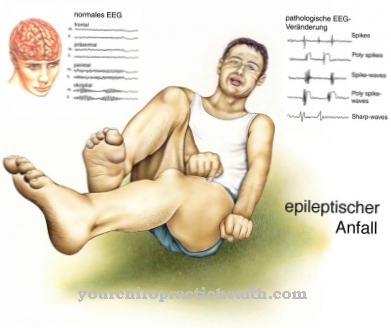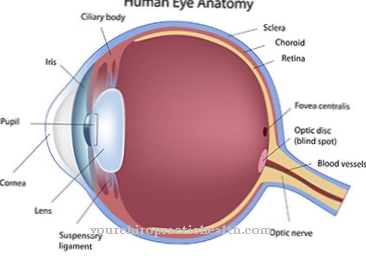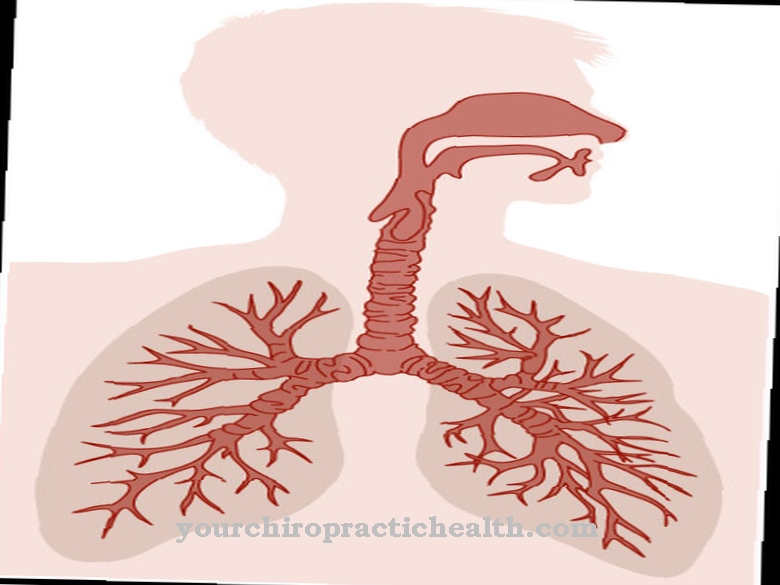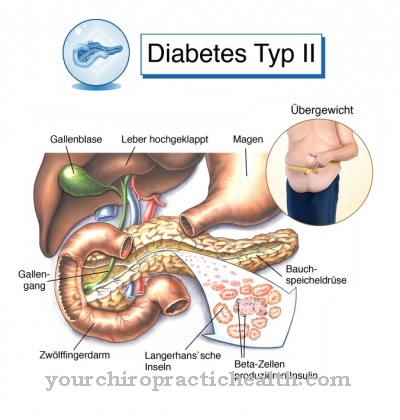As Rubinstein-Taybi Syndrome is called a genetic disease. This leads to different mental and physical impairments.
What is Rubinstein-Taybi Syndrome?

© bluebackimage - stock.adobe.com
The Rubinstein-Taybi Syndrome (RTS) is one of the genetic diseases. Those affected suffer from physical deformities and moderate intellectual disabilities. RTS is caused by abnormalities in chromosomes 16 and 22.
The syndrome was first described as part of a study in 1957. The name Rubinstein-Taybi syndrome can be traced back to the doctors Jack Herbert Rubinstein and Hooshang Taybi. The two medical professionals published an extensive study of the disease in 1963. The frequency of Rubinstein-Taybi syndrome is 1 in 120,000.
However, the information about the disease in the literature is quite different because until the 1980s only studies were carried out on children who lived in dormitories. In addition, by far not all cases of Rubinstein-Taybi syndrome are identified. It is not uncommon for the diagnosis to be made in adolescents. In addition, the symptoms of the syndrome include several variants. Furthermore, some children have only mild intellectual disabilities and no typical facial features.
causes
Rubinstein-Taybi syndrome shows up sporadically. In people with intellectual disabilities, the incidence is 1: 500. In rare cases it occurs in families, i.e. in siblings, twins or mother and child, which indicates an autosomal dominant inheritance. A microdeletion on the short arm of chromosome 16 and a gene mutation on the long arm of chromosome 22 are responsible for the development of Rubinstein-Taybi syndrome.
An important aspect of the defect is a synthesis disruption of the so-called CREB binding protein. This acts as a transcription factor or coactivator in phosphorylated form on cAMP-regulated gene expression. However, no precise facts about the pathogenesis are yet available.
Symptoms, ailments & signs
The typical manifestations of Rubinstein-Taybi syndrome include intellectual disabilities, which are individually different. Those affected usually have an intelligence quotient below a value of 50. The IQ range can range from 17 to 90.
Other characteristics of the genetic disorder are physical features that show up after birth despite normal pregnancy. Most sufferers have a relatively small head. The distance between the eyes is wide and the eyebrows are high and heavy. In addition, patients suffer from refractive errors and strabismus. Wearing glasses is usually necessary for correction.
Another physical abnormality is the lengthening of the nasal bridge in the lower direction. Some children also have had a reddish mark on their foreheads since birth. The ears are often abnormally shaped and set low. The patient's teeth can also be affected.
Many of them have premolarization of the incisors and canines, which is noticeable in the form of claw bumps. It is not uncommon for the palate to be too high and too narrow. The people affected by Rubinstein-Taybi syndrome are short stature. In addition, the spine is bent, vertebral abnormalities, and hip misalignment.
The joints are sometimes more flexible and the gait suffers from unsteadiness. Other particular abnormalities are the kinking of the thumb and big toes and increased hairiness on the body. The fine motor functions are affected less intensively.
But wider thumbs make the differentiated holding of objects more difficult. Malformations are also possible in the internal organs. These include renal agenesis (inhibition malformation), water sac kidneys or a heart defect such as a persistent ductus arteriosus, pulmonary stenosis and a ventricular septal defect.
In addition, the behavior of the children affected by Rubinstein-Taybi syndrome is also striking. They are difficult to feed even when they are babies, they are restless and often suffer from flu-like infections. There are also disorders of language development, which is much slower. Older children often stand out for their anxiety.
Diagnosis & course of disease
The diagnosis of Rubinstein-Taybi syndrome is considered straightforward, which can be attributed to the typical symptoms. With the help of imaging techniques, structural abnormalities in the brain can be identified. Other functional disorders can be diagnosed using neurophysiological methods such as electroencephalography.
In some cases, a molecular genetic test can also be used to detect a deletion on chromosome 16. Differential diagnoses of Mowat-Wilson syndrome and floating Harbor syndrome are also important. In most cases, Rubinstein-Taybi syndrome does not take an unfavorable course.
However, chronic kidney disease or heart disease can reduce patient life expectancy. In some cases, complications are also possible.
Complications
Due to Rubinstein-Taybi syndrome, patients suffer from various physical and mental disabilities, which have a very negative effect on everyday life and the quality of life of the person concerned. In most cases, relatives and parents are also affected by the symptoms and suffer from psychological disorders. The patients themselves are usually retarded and therefore require comprehensive support in their lives.
The head of those affected is very small and various deformities occur on the face. This can lead to bullying or teasing, especially among children or young people. In most cases, those affected are short and suffer from an unsteady gait. The motor skills are also significantly influenced.
Rubinstein-Taybi syndrome can also lead to malformations of the internal organs, so that patients may have a shorter life expectancy and are dependent on regular checkups in their life. Treatment is only possible symptomatically and does not lead to any particular complications. As a rule, many complaints can be restricted. However, the patient is always dependent on the help of other people in his life.
When should you go to the doctor?
Rubinstein-Taybi syndrome must always be treated by a doctor. It is a genetic disease that can only be treated symptomatically and not causally. A complete cure is therefore not possible. If the person concerned wants to have children, he or she should undergo genetic counseling in order to avoid inheriting the syndrome. As a rule, a doctor should be consulted with Rubinstein-Taybi syndrome if the person concerned suffers from a reduced intelligence. The head of the person concerned also appears small in relation to the entire body.
A short stature can also indicate Rubinstein-Taybi syndrome and should be examined by a doctor. There are uncertainties when walking. Since Rubinstein-Taybi syndrome can also lead to heart defects, the affected person should undergo regular examinations of the internal organs in order to avoid complications. The first diagnosis of the syndrome can be made by a general practitioner or a pediatrician. Further treatment then takes place by a specialist.
Treatment & Therapy
Treating the causes of Rubinstein-Taybi syndrome is not possible. Instead, an attempt is made to influence the symptoms positively and to support the child's development as early as possible. Important pillars of therapy are early intervention, occupational therapy, physiotherapy exercises and speech therapy programs.
Another important factor is not to flood the children with stimuli, to trust them and to provide social support. In addition, patients should have structured daily routines and their motor skills should be promoted.
Another important aspect is satisfying the emotional needs of the sick children. If the Rubinstein-Taybi syndrome occurs several times within the family, genetic counseling must take place.
prevention
Rubinstein-Taybi syndrome is a congenital genetic disease. It is therefore not possible to prevent it.
Aftercare
Rubinstein-Taybi Syndrome (RTS) is caused by a genetic change and is therefore a congenital disability. As a rule, the diagnosis is made in early childhood, the syndrome accompanies those affected for life. Life expectancy is not at all or only slightly below average. If there are severe heart defects, however, it is less than in other patients.
Follow-up care is useful in order to be able to support those affected accordingly. The aim is to develop the respective skills and to deal with the disease appropriately on a daily basis. For adult patients, due to their reduced IQ, work in conventional companies is not possible, but they can be employed in appropriate institutions. Such measures are part of the aftercare.
Individual skills need to be considered in both adults and children with RTS. Congenital heart diseases usually require surgical treatment. In this case, follow-up care also includes care in the clinic, subsequent check-ups with a specialist provide information about the success. Orthopedic abnormalities cannot be treated surgically, but are treated with regular exercises.
You can do that yourself
The genetic disease represents a challenge for the person concerned, but also for the relatives, in coping with everyday life. Since it comes to physical as well as mental impairments, the entire daily routine often has to be adjusted to the possibilities and needs of the patient.
To avoid excessive demands, parents should consider whether they would like to seek psychotherapeutic help themselves. The design of leisure activities and the fulfillment of daily tasks is very much oriented towards the patient's treatment plan. In order to improve the quality of life, in addition to a healthy and balanced diet, optimal leisure activities are particularly important. This should promote the joie de vivre of everyone involved. Parents' time off is just as important as doing activities together. The learning processes are to be aligned with the mental capabilities of the patient. Excessive demands or the application of pressure should be avoided.
The child should be informed as early as possible about their illness, its further course and the challenges. Early intervention is particularly important in order to improve mobility. Training units carried out there can then also be continued in the home. A stable social environment and well-structured daily routines are particularly important for patients. Hustle and bustle, stress and conflicts should be avoided.


.jpg)






















.jpg)


